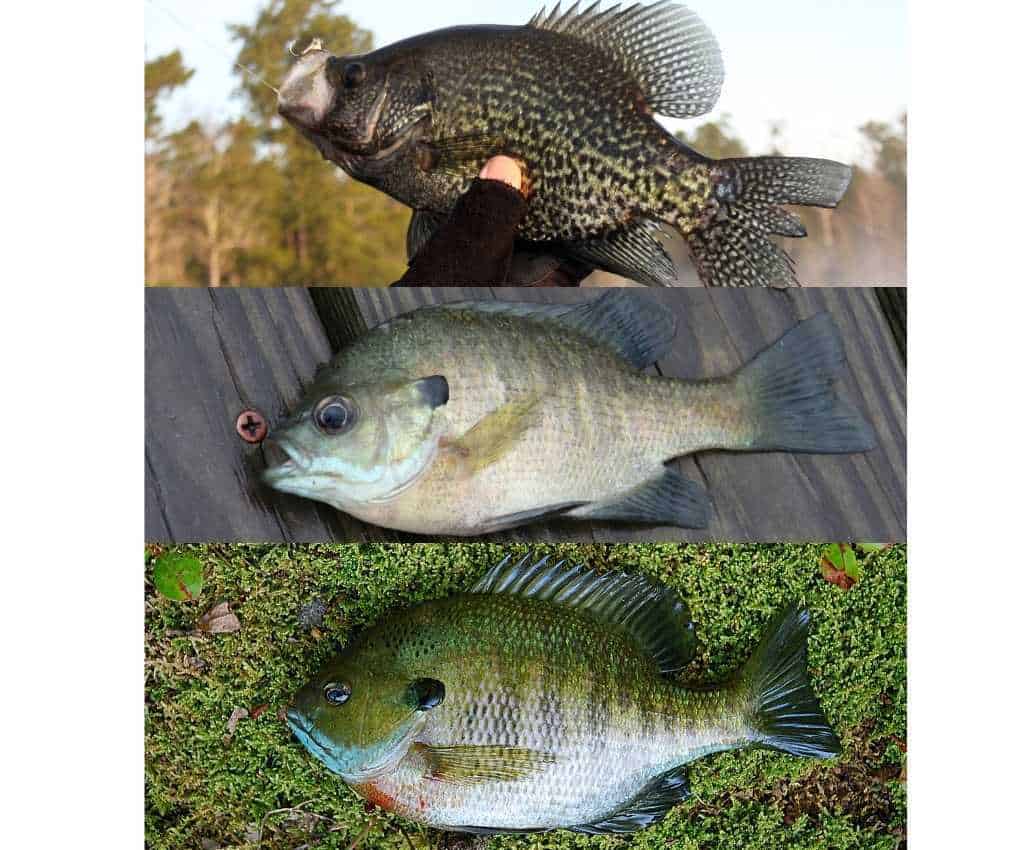Crappie vs Bluegill – The Differences! Is Crappie Better?
Crappie and bluegill share many of the same waters and other similarities. For this reason many people wonder about their differences or if they’re the same. Let’s answer, are bluegills the same as crappies?
Bluegills and crappie are not the same. Although from the same family they are different species of fish.White crappie are P. annularis species, black crappie are P. nigromaculatus species and bluegill are L. macrochirus species. Bluegill have a rounder and more colorful body than crappies.
This article will compare their tastes, textures, cooking methods, costs, mercury levels and whether one can substitute for the other in recipes. In addition, I’ll do a side-by-side comparison of their habitats, size, weight and discuss their nutritional benefits.
Crappie vs Bluegill: Habitats, Size, Weight, Appearance?
How can you tell the difference?
The easiest way to tell the difference between crappie and bluegill is by their colors and body shape. Bluegill has a blue head and chin and a yellow belly. Crappies are silvery with dark markings. Bluegill have a rounder body shape than the elongated shape of the crappie.

Another easy way to tell the difference between the two sunfish is by their dorsal fin. White crappie’s dorsal fin has 5-6 spines, black crappie has 7-8 spines and bluegill has 6-13 spines and 11-12 soft rays.
Bluegill has a shorter, small mouth than white or black crappie. The crappie head is larger than the bluegill which is more streamlined with the body.
Crappie and Bluegill Scientific Classifications, Families, Species
White crappie are from:
- Family: Centrarchidae
- Genus: Pomoxis
- Species: P. annularis
- Common nicknames: Goldring, silver perch, crappie
Black crappie are from:
- Family: Centrarchidae
- Genus: Pomoxis
- Species: P. nigromaculatus
- Common nicknames: Crappie
Bluegill are from:
- Family: Centrarchidae
- Genus: Lepomis
- Species: L. macrochirus
- Common nicknames: Bream, brim, sunny, perch.
Habitats
White Crappie
- Native to the Great Lakes, Hudson Bay and the Mississippi River basins from Canada, New York, South Dakota and Texas.
- When fishing you can find crappie in lakes, reservoirs and rivers.
- You can find them in murky waters.
Black Crappie
- Native to Canada, eastern and the western United States.
- When fishing they can be found in lakes, reservoirs and rivers.
- They prefer clear water over murky.
Bluegill
- Native to North America and can be found from Canada to northern Mexico.
- When fishing they can be found in streams, ponds, lakes and rivers.
- They like to hide under fallen logs, piers or in weeds.
Colors
- White crappies have a silvery color with dark vertical bars along the body. The back is greenish to brown.
- Black crappies have a silvery color with dark splotches along the body. The back is greenish to brow.
- Bluegills have an olive green upper body and light yellowish to orange belly. The sides of the head and chin are iridescence blue or purple. They have dark vertical bands on its sides. A breeding male bluegill will have more orange than yellow on the belly.
Appearance
Dorsal Fins
- White crappie has one dorsal fin with 5-6 spines.
- Black crappie has one dorsal fin with 7-8 spines.
- Bluegill has one dorsal fin with 6-13 spines and 11-12 rays.
Mouth
- The white crappie jaw does not extend past the eye line. The mouth does not have an upward shape.
- The black crappie jaw does not extend past the eye line. The mouth has an upward curve or shape.
- The bluegill mouth is small, and the jaw doesn’t extend past the eye line.
Scales
- The scales on all three sunfish are similar across the body.
Size and Weight
- White crappies average 9-10 inches long and weigh between 1/2 pound to 1.5 pounds.
- Black crappies average 8-10 inches long and weigh 3/4 pound to 2 pounds.
- Bluegill average 6-7″ long and weighs less than 2 pounds.
Bluegill are more rounded and have pronounced sides top to bottom, flatter looking.
Check out all the differences between them and bass in my article, Bass – What’s The Difference? Let’s Compare.
Diet
White crappie consume the following:
- Plankton
- Crustaceans
- Small fish
- Insects
Black crappie consume the following:
- Plankton
- Crustaceans
- Small fish
- Insects
Bluegill consume the following:
- Worms
- Small crustaceans
- Insects
- Insect larvae

Bluegill Fishing
When fishing for bluegill sunfish, bluegill fishing reports state the best time is during the spring and summer spawn.
Typically, the sunfish will be in two to six feet of water under cover. Bait may include a piece of worm, crickets, grasshoppers and red wrigglers.
Crappie fishing: the crappie is a popular sport fish also.
Always check your local visitor center, State parks and advisory council for fishing tips, licenses, restrictions and regulations. State parks are a great place to learn about fishing, tips, fish biology, species, panfish and featured content about related topics.
Crappie and Bluegill Taste and Texture
One of the most important things people takes into consideration when choosing a fish in a store or fishing is its taste. When comparing the two fish, does one taste like the other?
Crappie has a milder taste than bluegill taste which is mild to sweet. Crappie taste less fishier than bluegill. Bluegill has a firmer texture than crappie which is softer and smoother. Crappie tend to be more delicate and flakey than bluegill.
To conduct original research about taste, I polled many of my clients, readers and members of food groups I belong to. The following are the results of my poll which consisted of 100 people.
I asked which fish, crappie vs bluegill, tasted better?
- 78% preferred the taste of bluegill.
- 22% preferred the taste of crappie.
To conduct more taste research, I set up a taste test at home. Both fish were cooked and seasoned the same way. The results of my home test were similar to the poll above.
Check out how white perch compared in my article, White Perch: Are They The Same? We Compare.
The following video explains how to clean and cook bluegill.
Substitutions
When preparing recipes for dinner it’s not always possible to locate the type of fish in a store or while fishing. If you have one sunfish, you may ask, can I substitute one for the other?
Bluegill can substitute for crappie although its flavor is slightly stronger than crappie. Bluegill has a firmer texture allowing it to be in many crappie recipes and more cooking methods. They both can be cooked using similar methods like baking, broiling, steaming and frying.
One thing to remember when choosing between the two fish is the size of the fillet. Most of the time the crappie fillet is larger or is easier to fillet if you have a whole fish.
The best crappie fish substitutes include the following:
- Cod
- Tilapia
- Bluegill
- Lake herring
- Pollock
Bluegill substitutes:
- White crappie
- Black crappie
- Tilapia
- Pollock
- Lake herring
Bluegill Crappie Mercury Levels
The EPA and The Food and Drug Administration have issued warnings and suggestions regarding mercury levels in fish and how often they should be consumed1. This is especially important for pregnant women, developing children and young infants.
They established a list of best fish, good choices and ones to avoid based on their mercury levels. Therefore, which sunfish has more mercury?
Bluegill and crappie have similar levels of mercury. Both fish are listed on the FDA’s best choice of fish regarding mercury levels.
If you’re pregnant, breast feeding or has a young child, Always check with a physician prior to eating new foods or changing your dietary habits.
These mercury warnings can change over time or affect only a particular area or state. Please check with your local EPA and FDA for the current recommendations especially before fishing2.
Bluegill and Crappie Costs
The costs for crappie and bluegill will vary depending on how they are caught when fishing. When purchasing any fish, be sure to check the label. Therefore, which fish is more expensive?
Bluegill is more expensive than crappie. The average cost for wild crappie fillets is $22 per pound. The average cost for wild bluegill fillets is $25.36 per pound.
To conduct original research on prices, I visited various stores and checked the cost.
First, I checked online at Walleye Direct and found the following prices:
- Wild, crappie fillets
- $22.00 per pound
- Wild, bluegill fillets
- $25.36 per pound
For stocking ponds, Pond King has the following price per bluegill crappie:
- Black crappie – $1.00 per 3-4″ fish
- Bluegill – $0.75 per 3-4″ fish

Nutrition Value Difference
The following are nutrients per 4 ounces:
| Nutrient | Bluegill, raw (4 Ounces) | Crappie, raw (4 Ounces) |
| Calories | 129 | 137 |
| Fat | 0.8 g | 1.3 g |
| Saturated Fat | 0.5 g | 0.9 g |
| Cholesterol | 97 mg | 80 mg |
| Protein | 22 g | 25 g |
| Sodium | 82 mg | 49 mg |
| Omega-3 | 0.16 g | 0.29 g |
| B-6 | 0.1 mg | 0.1 mg |
| B-12 | 2.0 mcg | 2.1 mcg |
| Thiamin | 0.10 mg | 0.07 mg |
| Riboflavin | 0.10 mg | 0.08 mg |
| B5 | 0.7 mg | 0.8 mg |
| Iron | 1.7 mg | 0.9 mg |
| Niacin | 1.4 mg | 1.7 mg |
| Folate | 17.0 mcg | 6.3 mcg |
| Potassium | 395 mg | 357 mg |
| Magnesium | 34 mg | 39 mg |
| Phosphorus | 203 mg | 259 mg |
| Calcium | 90.4 mg | 85.8 mg |
| Zinc | 1.6 mg | 0.5 mg |
| Selenium | 14.2 mcg | 13.2 mcg |
Nutrient Sources34 ((USDA FoodData Central: Crappie))
Both fish contain a good number of minerals and vitamins. At first glance it’s difficult to determine which fish provides more. Therefore, which one is healthier?
Crappie is healthier than bluegill due to its higher percentage of heart healthy omega-3 fatty acids, protein and B vitamins. They contain 85% more heart healthy omega-3s and more B12, B5, B3, magnesium and phosphorus.
Bluegill also contains a good number of vitamins and minerals. They provide more thiamin, riboflavin, folate, iron, potassium, calcium, zinc and selenium.
The extra omega-3 fatty acids is what separates the two fish and gives crappie the advantage. Keep reading the next section to find out why omega-3 fatty acids are important for your health.
Since the sunfish are difficult to locate in stores, I’ll consume either fish available to me for their nutrient content, taste and health benefits.
Crappie and Bluegill Health Benefits
Omega 3 Fatty Acids
The omega-3 fatty acids are heart healthy and help keep arteries healthy. The omega-3s may help with the following:
- Keeping bad cholesterol low.
- Keeping good cholesterol high.
- Reducing inflammation.
- Reducing plaque build-up.
- Lowering triglycerides
- Help keep the heart rhythms more normal.
DHA and EPA, two of the fatty acids, are associated with lowering blood pressure and improving the health of blood vessels ((National Center for Biotechnology: Marine Omega-3 Supplementation and Cardiovascular Disease)).
Studies suggest omega-3s can help reduce joint pain and stiffness in people with rheumatoid arthritis. They may also boost the effectiveness of anti-inflammatory drugs.

B Vitamins
The B vitamins provided include B1 (thiamin), B2 (riboflavin), B3 (niacin), B9 (folate) B6, B12 and B5. B vitamins help support the following:
- Energy levels.
- Red blood cells.
- Cardiovascular disease.
- Digestion.
- Nerve function.
- Brain function.
Magnesium
Magnesium calms and relaxes the whole body including blood vessels. Magnesium has been shown to help improve sleep related problems like insomnia ((National Institutes of Health: Magnesium)).
Magnesium helps keep blood pressure levels balanced and stable. A recent study researched 22 studies and concluded magnesium supplementation decreased diastolic and systolic blood pressure5.
Magnesium helps control muscle and nerve function, blood sugar and blood pressure.
In the muscles and heart, magnesium competes with calcium to help the muscles relax after contracting. When the body is low in magnesium, calcium can over stimulate the heart muscle’s cells causing a rapid or irregular heartbeat.
Find out how rock bass compared in my crappie article.
Calcium
Calcium is important for blood pressure and the heart. Harvard Health reports calcium helps maintain blood pressure because it helps to control the relaxing and tightening of blood vessels6.
Calcium also helps the following:
- Build and maintain strong bones.
- Muscles need calcium to function properly.
- Improve nerve function.
Potassium
Potassium helps the body get rid of excess sodium which helps reduce fluid build-up. These help keep systolic and diastolic blood pressure lower ((American Heart Association: How Potassium Can Help Control High Blood Pressure)).
The more potassium you consume, the more sodium your body will lose. Consuming too much sodium or not enough potassium throws off the delicate balance the kidneys need to remove the excess water7.
According to Harvard Health, a number of studies have shown a connection between low potassium levels and increased blood pressure8.
Selenium
There are 14.2 mcg of selenium per four ounces. Selenium is a nutrient which doesn’t receive much press. I’m unsure why many don’t write about it more because studies9 show selenium may help to protect the following:
- Cognitive issues
- Heart disease
- Thyroid
- The immune system
Phosphorus
Phosphorus has been shown in scientific research to help with the following:
- Promote teeth and bone strength.
- Muscle recovery after exercise.
- Muscle contraction.
- Help the body store and manage energy.
- Help the kidneys remove waste.
- Promote healthy nerve conduction.
As a Certified Health Coach many of my clients ask me about sunfish. In addition to educating my Health Coaching clients about pumpkinseed and bluegill, I have researched, purchased and consumed both fish for 20 years prior to, during and after writing this article.
If you have any questions about this article don’t hesitate to email us. You can find an email on our contact page.
Read Next – More Fish vs Fish Articles!
Black Crappie vs White Crappie – What’s The Difference?
Bass vs Catfish – What’s The Difference? Let’s Compare
Brown Trout vs Salmon – Are They The Same? Let’s Compare
- FDA: Advice about Eating Fish [↩]
- National Center for Biotechnology Information: Mercury accumulation in largemouth bass (Micropterus salmoides) in a Florida lake [↩]
- The Topeka Capital-Journal: Keto, Paleo or Atkins diet? Hunting, fishing can help trim your waistline in 2020 [↩]
- Nutritiondata: Fish, sunfish, raw [↩]
- National Center for Biotechnology Information: Effect of magnesium supplementation on blood pressure: a meta-analysis [↩]
- Harvard Health: Key minerals to help control blood pressure [↩]
- National Center for Biotechnology Information: The Effect of the Sodium to Potassium Ratio on Hypertension Prevalence: A Propensity Score Matching Approach [↩]
- Harvard Health: Potassium lowers blood pressure [↩]
- National Institutes of Health: Selenium [↩]
